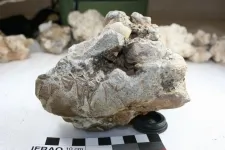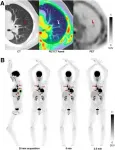Depression, suicidal thoughts plague ailing coal miners, study finds
2021-07-08
(Press-News.org) More than a third of coal miners and former coal miners suffering from black lung disease struggle with depression, and more than one in 10 has recently considered suicide, a new study finds.
The study is believed to be the first to examine mental-health issues in a large population of coal miners in the United States. Based on the troubling results, the researchers are calling for more mental health resources and treatment for current and former miners. They also are urging further study of potential contributors to the problem, including social determinants of health, substance use and workplace safety.
"Although coal mining is on the decline, the rates of black lung in Southwest Virginia continue to increase. Coal miners in Central Appalachia face disparities in health related to a range of complex social, economic, occupational and behavioral factors," said researcher Drew Harris, MD, a pulmonary medicine expert at UVA Health. "This study highlights the unrecognized crisis of mental illness in miners that warrants urgent attention, resources and expanded care."
Miners' Mental Health
Harris serves as the medical director of the Black Lung Clinic at Southwest Virginia's Stone Mountain Health Services, the only federally funded black lung clinic in Virginia. Black lung is a progressive lung illness caused by inhaling toxic coal and rock dust within coal mines. The dust literally blackens the insides of the lungs and leaves patients struggling to breathe. This devastating disease has few treatment options and is increasingly being diagnosed in Central Appalachian coal miners: Out of more than 1,400 coal miners X-rayed in the last year at Stone Mountain, more than 15% had progressive massive fibrosis, the most severe form of black lung.
To gauge the mental wellbeing of black-lung patients, Harris and his colleagues reviewed data collected at the clinic since 2018 assessing patients for anxiety, depression and post-traumatic stress disorder (PTSD).
More than 2,800 miners voluntarily completed a mental-health survey. The average age was 66; 99.6% were white; and 99.7% were male.
Of the participants:
883 patients, or 37.4%, reported symptoms consistent with major depressive disorder.
1,005 patients, or 38.9% had clinically significant anxiety.
639 patients, or 26.2%, had symptoms of PTSD.
295 patients, or 11.4%, had considered suicide in the last year. (For comparison, this figure is only 2.9% among Virginia men overall.)
"These rates of mental illness far exceeded those documented in coal mining populations internationally," the researchers write in a new scientific paper outlining their findings.
Rates skewed highest among sicker patients who required supplemental oxygen to help them breathe. Among that group, 47.7% reported anxiety; 48.5% reported depression; and 15.9% reported considering suicide.
The researchers note that depression and other mental-health issues not only affect patients' quality of life but can reduce the likelihood they will stick with their medications.
"The rates of mental illness identified in this large population of U.S. coal miners is shocking," Harris said. "Improved screening and treatment of mental illness in this population is an urgent, unmet need that warrants urgent action."
INFORMATION:
Findings Published
The researchers have published their findings in JAMA Network Open. The research team consisted of Harris, Timothy McMurry, Amanda Caughron, Jody Willis, Justin C. Blackburn, Chad Brizendine and Margaret Tomann, McMurry disclosed that he serves as a statistical consultant for the National Institute of Occupational Health and Safety.
To keep up with the latest medical research news from UVA, subscribe to the Making of Medicine blog at http://makingofmedicine.virginia.edu.
[Attachments] See images for this press release:

ELSE PRESS RELEASES FROM THIS DATE:
2021-07-08
Evidence from an ancient eggshell has revealed important new information about the extreme climate change faced by human early ancestors.
The research shows parts of the interior of South Africa that today are dry and sparsely populated, were once wetland and grassland 250,000 to 350,000 years ago, at a key time in human evolution.
Philip Kiberd and Dr Alex Pryor, from the University of Exeter, studied isotopes and the amino acid from ostrich eggshell fragments excavated at the early middle Stone Age site of Bundu Farm, in the upper Karoo region ...
2021-07-08
Reston, VA--A performance evaluation of the uEXPLORER total-body PET/CT scanner showed that it exhibits ultra-high sensitivity that supports excellent spatial resolution and image quality. Given the long axial field of view (AFOV) of the uEXPLORER, study authors have proposed new, extended measurements for phantoms to characterize total-body PET imaging more appropriately. This research was published in the June issue of The Journal of Nuclear Medicine.
uEXPLORER is the world's first commercially available total-body PET scanner. The scanner has an AFOV of 194 cm, which allows PET data collection from the ...
2021-07-08
Scientists at the Department of Energy's Oak Ridge National Laboratory and the University of Tennessee, Knoxville, have found a way to simultaneously increase the strength and ductility of an alloy by introducing tiny precipitates into its matrix and tuning their size and spacing. The precipitates are solids that separate from the metal mixture as the alloy cools. The results, published in the journal Nature, will open new avenues for advancing structural materials.
Ductility is a measure of a material's ability to undergo permanent deformation without breaking. It determines, among other ...
2021-07-08
Batteries are potentially a game-changing technology as we decarbonize our economy, and their benefits are even greater when shared across communities, a University of Otago-led study has found.
Co-author Associate Professor Michael Jack, Director of the Energy Programme in the Department of Physics, says reducing costs are seeing rapid deployment of batteries for household use, mainly for storing solar and wind power for later use, but they could have a variety of uses in a future electricity grid.
"For example, they could be used to feed energy back into the grid when there is a shortfall in renewable supply. ...
2021-07-08
Firearm purchases and firearm violence surged dramatically during the first five months of the COVID-19 pandemic, according to a new study from the UC Davis Violence Prevention Research Program (VPRP), published in Injury Epidemiology.
From March through July 2020, an estimated 4.3 million more background checks for firearm purchases occurred nationwide than would have ordinarily -- an 85 percent increase. The total number of firearm purchases during this period was 9.3 million.
From April through July 2020, there was a 27% increase in interpersonal firearm injuries, which includes firearm homicides or nonfatal firearm assault injuries. This is approximately 4,075 more injuries ...
2021-07-08
Eight pieces of salmon-based maki, nigiri or sashimi or maki unagi (eel) is the safest combination of sushi for adult and adolescent populations. That is one of the findings of TecnATox (Centre for Environmental, Food and Toxicological Technology), a joint research group from the URV and the Pere Virgili Health Research Institute (IISPV), which has analysed the presence of arsenic and various heavy metals in sushi. The consumption of sushi has increased significantly since the start of the 21st century, as has the number of restaurants offering it throughout the region. Although eating fish is recommended because of its high nutritional value, it can also lead to exposure to contaminants, such as heavy metals. Likewise, rice is a food that provides many nutrients ...
2021-07-08
The rationale for the research is in the fact that despite the high number of recognized Indigenous groups who are struggling to maintain their languages, cultures, and identities in Russia, there is little research done on the matters of cultural and linguistic revitalization. This study sought to address this gap by exploring the views of two Indigenous groups, Karelian and Mari, on the development of their Indigenous languages and educational strategies to protect and revive their languages. The study relied on in-depth one-on-one interviews with 20 participants, ten from each Indigenous group.
The findings show that despite older generations' relative proficiency and interest in their respective Indigenous languages, motivation to master them is ...
2021-07-08
ATLANTA - JULY 8, 2021 - Overall cancer death rates continue to decline in men and women for all racial and ethnic groups in the United States, according to the latest Annual Report to the Nation on the Status of Cancer. During 2001 to 2018, declines in lung cancer death rates accelerated, and death rates for melanoma declined considerably in more recent years, reflecting a substantial increase in survival for metastatic melanoma. However, the report finds that for several other major cancers, including prostate, colorectal and female breast cancers, previous declining trends in death rates slowed or disappeared.
The report, appearing in JNCI: The Journal of the National Cancer Institute, also finds that overall cancer incidence ...
2021-07-08
Tooth loss is a risk factor for cognitive impairment and dementia--and with each tooth lost, the risk of cognitive decline grows, according to a new analysis led by researchers at NYU Rory Meyers College of Nursing and published in JAMDA: The Journal of Post-Acute and Long-Term Care Medicine. However, this risk was not significant among older adults with dentures, suggesting that timely treatment with dentures may protect against cognitive decline.
About one in six adults aged 65 or older have lost all of their teeth, according to the Centers for Disease Control and Prevention. Prior studies show a connection ...
2021-07-08
The average body size of humans has fluctuated significantly over the last million years and is strongly linked to temperature.
Colder, harsher climates drove the evolution of larger body sizes, while warmer climates led to smaller bodies.
Brain size also changed dramatically but did not evolve in tandem with body size.
An interdisciplinary team of researchers, led by the Universities of Cambridge and Tübingen, has gathered measurements of body and brain size for over 300 fossils from the genus Homo found across the globe. By combining this data with a reconstruction of the ...
LAST 30 PRESS RELEASES:
[Press-News.org] Depression, suicidal thoughts plague ailing coal miners, study finds





